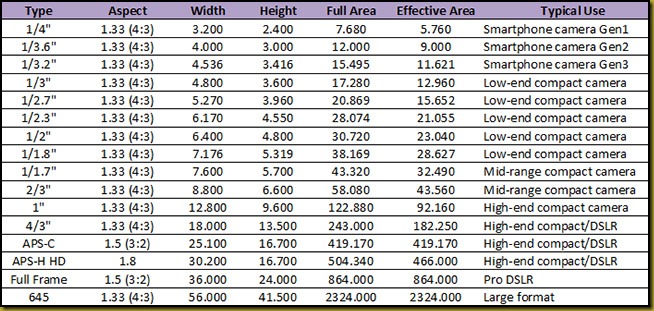Digital cameras—Sensor size is king
When it comes to image quality with a digital camera the Number One consideration is the physical size of the digital sensor—not to be confused with megapixel resolution. The larger the sensor size the better the image quality. You can have a pretty crappy lens used with a large sensor and that will produce better images every time than a better lens used with a tiny sensor.
Yet, interestingly, the one piece of information that advertisements for digital cameras almost never provided is the sensor size. Adverts will tell you almost anything else you might want to know about the camera but they will almost never tell you the sensor size. I have never seen a camera advert that mentioned the sensor size.
They tell you the resolution in megapixels (which is actually quite pointless). They tell you how many elements the lens has. They tell you the f-stop of the lens. They tell you the LCD display size and the zoom of the lens. They might even tell you the ISO range and the shutter speeds. But almost never do they bother with the most important metric of all that relates to image quality—the physical size of the sensor.
To find out the sensor size being used with almost any camera you have to go digging around the Web. You need to refer to sites like Digital Photography Review (DPReview, see sidebar) and hope that they have reviewed the camera you are considering.
As a bit of help I have put together the following chart which gives you some idea of the sensor sizes commonly used in digital cameras including smartphone cameras. Note the the “Typical Use” is just that and there are exceptions.
The sensor width and height is in millimetres. The full area and effective area is in square millimetres.
As you can see the 1/4” and 1/3.6” sensors used in Gen 1 and Gen 2 mobile phones were tiny with widths of 3.2 and 4.0 mm. The effective imaging area was sub-ten square millimetres.
With the Gen 3 mobile phones the commonly used sensor size is about 25 percent bigger. They use the 1/3.2” sensor. This sensor is still only 4.5 by 3.4 mm with an effective imaging area of 11.621 square millimetres. But this 25 percent of additional effective imaging area makes a visible difference to the picture quality, as can be seen if you look at pictures taken with the new Nokia Lumia 920, the HTC 8X, or the Samsung SIII. But even with this improvement the picture quality cannot touch that of pictures taken using even larger sensors.
This is why you often see it written that even a low-end compact camera provides better image quality than the best smartphone camera. The single reason for this is the sensor size. And because of the format of smartphones—in that they are very thin and are likely to remain like that—unless there is some kind of technology break-through it is unlikely that larger sensors will be used in them any time soon.
The problem smartphone manufacturers have is that the larger the sensor the further the lens has to be mounted away from the sensor and the larger the lens needs to be. These two requirements don’t go well with keeping smartphones ‘thin’ and light.
So, until some magical technological break-through is made, if you want to take better quality pictures that:
- have less motion blur (camera shake),
- are in sharper focus (crisper),
- are not covered in digital noise static and artefacts (especially when taken in low light),
- can be printed at larger than 5x7” without getting that soft foggy look or suffering from grain,
- can be cropped down without fear of a totally crappy picture when printed at A5 size (21 x 15 mm) being the result,
- can be viewed full screen on a monitor that is bigger then 10” without looking bad,
- could be printed as an A3 (30 x 42 mm) or even A2 (42 x 60mm) poster and look acceptable,
then you need to use something with a larger sensor than a smartphone camera.


